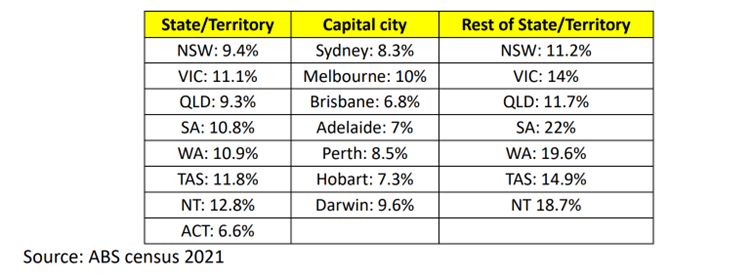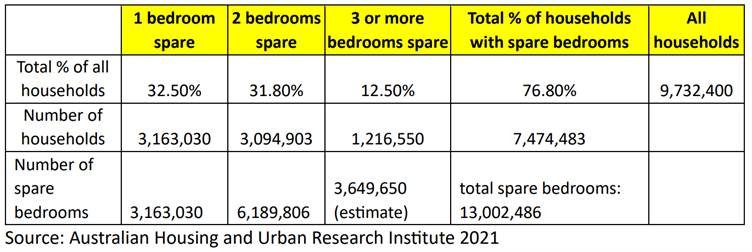[ad_1]
Inside Australia’s 900,000 empty properties and 13 million spare rooms

Amidst hovering rents and dwindling availability, a staggering variety of properties throughout Australia stay unoccupied, together with 873,488 used as secondary residences and 13 million spare bedrooms.
This paradox poses a vital query: Can these empty areas provide an answer to the rising housing affordability disaster, notably in hard-hit areas corresponding to Sydney and Melbourne?
Whereas housing shortages are a world concern, property professional Ritesh Tandon (pictured above) mentioned the existence of vacant properties in a rustic with a rising inhabitants raised questions concerning the effectivity and accessibility of Australia’s actual property market.
“The affect of empty homes on the Australian group is multifaceted,” mentioned Tandon, founding father of Melbourne-based consumers company Nest or Make investments. “Firstly, it contributes to the widening hole between the property haves and have-nots.”
“The dream of homeownership, as soon as thought of a basic a part of the Australian identification, is slipping away for a lot of as housing costs proceed to soar. This has socio-economic implications, as steady housing is an important consider figuring out one’s total well-being.”
Australia’s vacant properties: Twenty years of constant information
Australia’s vacant properties should not a brand new situation.
The 2021 Census reveals that 10.1% (1,043,776 properties) of Australia’s 10,318,997 personal dwellings have been unoccupied on the night time of the Census.
Some 89% of the dwellings have been in use as a main residence, 9.7% have been in use however not as a main residence and 1.3% confirmed no signal of current use.
This pattern hasn’t modified since 2006 whereby the common unoccupied dwellings stay across the 10% mark.
Round 10% of dwellings are at all times empty in Australia

Whereas this may increasingly appear {that a} very massive proportion of Australia’s housing is unlived in, the truth is dwellings are recognized as unoccupied for a number of causes.
In response to Australian Housing and City Analysis Institute, high causes for a dwelling to be unoccupied are:
1. Properties are being renovated
2. Properties being offered, up on the market or awaiting switch
3. Newly constructed or purchased properties the place nobody has moved in but
4. Rental properties awaiting new tenants
5. Individuals dwelling away briefly from dwelling throughout the census rely (travelling or visiting different properties)
6. Properties are deemed unliveable
7. Deceased estates or properties inherited by means of wills or household estates could stay unoccupied on account of disputes amongst inheritors.
9. Properties owned by folks presently dwelling abroad
10. Properties being land banked, that’s held vacant till the native space economics (or private circumstances) make it extra worthwhile to promote or redevelop the property.
“Different causes being the rise of short-term rental platforms like Airbnb,” mentioned Tandon. “Shifting demographics, corresponding to inhabitants decline in sure areas or altering group dynamics, can result in homes being left empty as demand for housing decreases specifically areas.”
Unoccupied dwellings unfold throughout Australia
The prevalence of empty homes is just not evenly distributed throughout the nation.
Amongst the states and territories, Northern Territory had probably the most unoccupied dwellings at 12.8%. Melbourne was the highest capital metropolis at 10%. Regional Western Australia and South Australia had probably the most unoccupied dwellings with 19.6% and 22% respectively.
Degree of unoccupied dwelling throughout Australia

The variety of homes in use as a main residence have been analysed utilizing Multi-Company Knowledge Integration Venture (MADIP) figures sourced from the ABS.
These are the homes which might be assigned as the same old residence of no less than one particular person within the inhabitants snapshot on June 30, 2021.
Map of main residence in use throughout all native authorities areas in Australia

Be aware: Color signifies the share of homes used as a main residence. For instance, a circle shaded darkish pink signifies that greater than 92% of homes within the space are used as a main residence, whereas a circle shaded yellow signifies that lower than 80% of homes within the space are a main residence. Circle measurement signifies the variety of homes within the space. Areas with bigger circles have a better variety of homes relative to areas with smaller circles. For the total interactive map, click on right here.
Australia’s 13 million empty rooms
Regardless of Australia’s uneven distribution of housing, a deeper inefficiency lies inside particular person properties – hundreds of thousands of unused bedrooms.
An evaluation of the ABS survey on Revenue and Housing revealed that just about 76.8% of households, totalling round 7.4 million, reside in properties with surplus bedrooms, leading to roughly 13 million unused sleeping areas.
These additional rooms, whereas not used for sleeping, play essential roles corresponding to dwelling places of work and leisure areas.
Furthermore, AHURI analysis signifies that older owners usually tend to have spare bedrooms, notably within the 55–64 and 64–74 age teams.
Variety of personal dwellings with spare rooms

The difficulty of Australia’s empty properties and rooms
With the difficulty nicely documented, it’s clear governments learn about Australia’s empty homes and rooms and as evidenced above, have moved to handle the difficulty.
Nevertheless, Tandon criticised some insurance policies saying they didn’t go far sufficient.
For instance, the Victorian authorities launched varied taxes to assist deal with the dearth of housing provide in Victoria.
“Vacant residential land tax is the one launched by the State Income Workplace however solely applies to vacant properties below 16 councils within the internal and center ring suburbs of Melbourne out of whole 79 councils in Victoria,” Tandon mentioned.
“Furthermore, there are exemptions to it which means if the property was used as a vacation dwelling and occupied by the proprietor for no less than 4 weeks of that 12 months, they don’t pay the above tax.”
Subsequently, regardless of having deterrents in place, Tandon mentioned the tax insurance policies don’t appear to be overly efficient and ignore 80% of the state jurisdictions which appear to be having many of the vacant properties.
“Owners with spare bedrooms should pay earnings tax on the lease acquired from the tenants leasing the rooms,” Tandon mentioned.
“For pensioners, this may imply the quantity they obtain as lease reduces their pension quantity. For these causes, many individuals keep away from contemplating renting out a room, persevering with the issue.”
The answer for Australia’s empty properties and rooms
Thousands and thousands of unused bedrooms and empty homes forged a protracted shadow over Australia’s housing disaster.
Past the person price to these struggling to search out reasonably priced properties, it raises questions on fairness and environment friendly land use.
To deal with this advanced situation, Tandon shared some potential options:
Tax incentives for renting spare rooms
- Pensioners: Supply 100% tax-free rental earnings on spare rooms, encouraging them to contribute to the housing market with out monetary burden.
- Non-pensioners: Present a 50% low cost on tax payable (alongside the traces of capital features tax) for earnings from renting spare rooms, incentivising owners to share underutilised area.
“Furthermore, the scope for vacant residential land tax must be expanded to all properties throughout the state,” Tandon mentioned.
The prevalence of empty homes and rooms in Australia is a fancy situation with far-reaching penalties. It challenges the normal notion of homeownership and highlights the necessity for considerate city planning and coverage interventions.
“Balancing the pursuits of property traders with the housing wants of the broader group is a fragile activity, however addressing this silent disaster is essential for making a extra equitable and sustainable future for Australia,” Tandon mentioned.
Associated Tales
Sustain with the most recent information and occasions
Be a part of our mailing checklist, it’s free!

[ad_2]

